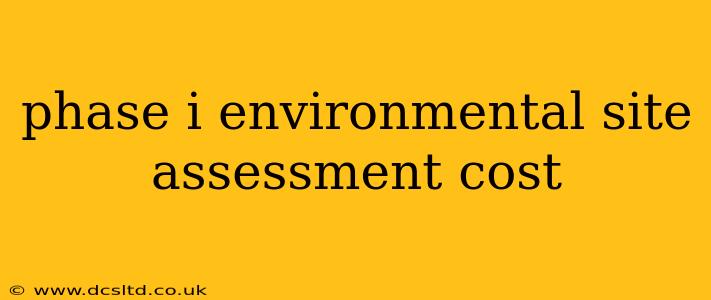A Phase I Environmental Site Assessment is a crucial first step in any real estate transaction or development project. Understanding the cost involved is essential for effective budgeting and planning. This guide will delve into the factors influencing the price of a Phase I ESA, providing you with a clearer picture of what to expect.
What Factors Determine the Cost of a Phase I Environmental Site Assessment?
Several factors significantly impact the final cost of a Phase I ESA. These include:
-
Property Size and Complexity: Larger properties naturally require more extensive investigation, increasing the time and resources needed. Complex properties with multiple buildings, diverse land uses, or a history of varied industrial activities will also command higher fees.
-
Location: Geographic location plays a role. Assessments in densely populated urban areas often involve more research into historical records and regulatory requirements, potentially increasing costs. Rural properties, while seemingly simpler, may require more travel time for site visits, affecting the overall expense.
-
Historical Use of the Property: Properties with a history of industrial or hazardous material use will necessitate a more thorough investigation, including potentially more extensive records searches and potentially specialized sub-consultant work. The more intensive the research, the higher the cost.
-
Scope of Work: The scope of work defined by the client and the assessor dictates the level of detail and the extent of the investigation. A basic assessment focusing solely on readily available information will be less expensive than one requiring extensive field work or specialized analysis. Specific client requests beyond standard Phase I ESA practices will add cost.
-
Regulatory Requirements: Local, state, and federal regulations vary, impacting the level of detail and compliance requirements needed for the assessment. These regulations can influence the cost, especially if specific environmental permits or approvals are required.
How Much Does a Phase I Environmental Site Assessment Typically Cost?
Providing an exact cost is difficult without knowing the specifics of your project. However, a general range is helpful. The cost of a Phase I ESA can range from $1,000 to $10,000 or more. Smaller, simpler properties with straightforward histories might fall at the lower end of this range, while larger, more complex sites with potentially complicated histories could easily exceed $10,000.
Remember, this is just an estimate, and the actual cost can vary significantly based on the factors listed above.
What is Included in a Phase I Environmental Site Assessment?
A standard Phase I ESA typically includes:
- Site Reconnaissance: A visual inspection of the property to identify potential environmental concerns.
- Records Review: A comprehensive review of historical records, including government databases, aerial photographs, and property ownership records.
- Interviews: Interviews with current and past owners or occupants of the property to gather information about past land uses and potential environmental issues.
- Report Preparation: A detailed written report summarizing the findings of the investigation and classifying the environmental conditions.
What are the Different Types of Phase I Environmental Site Assessments?
While the standard Phase I ESA covers the basics, additional services can be included, influencing the final cost. For instance, some clients may require:
-
All Appropriate Inquiries (AAI): This is often a critical component of a Phase I ESA, ensuring compliance with environmental regulations regarding liability. This adds cost.
-
ASTM E1527-13: Compliance with this standard ensures a more comprehensive and legally defensible assessment.
-
Specific Contaminant Investigations: If particular concerns exist about specific contaminants (e.g., asbestos, lead paint), targeted investigations will increase the cost.
How Can I Reduce the Cost of a Phase I Environmental Site Assessment?
While maintaining a thorough and comprehensive assessment is paramount, some strategies can help manage costs:
-
Clearly define the scope of work: Focus on the essential elements and avoid unnecessary add-ons.
-
Shop around and compare quotes: Obtain quotes from multiple environmental consulting firms to compare pricing and services.
-
Choose the right consultant: Select a firm with experience and expertise appropriate to the specific site and its potential complexities.
Are there any alternatives to a full Phase I ESA?
In certain limited circumstances, a less comprehensive review might suffice, such as a preliminary site visit or desktop review. However, these options carry more risk and are not suitable replacements for a full Phase I ESA in most situations. A qualified environmental professional should determine the appropriate level of assessment based on the specific circumstances of the property and project.
This guide provides a general overview. Always consult with a qualified environmental professional to determine the specific costs and scope of work needed for your individual property and project. This ensures compliance with all applicable regulations and protects your interests.
